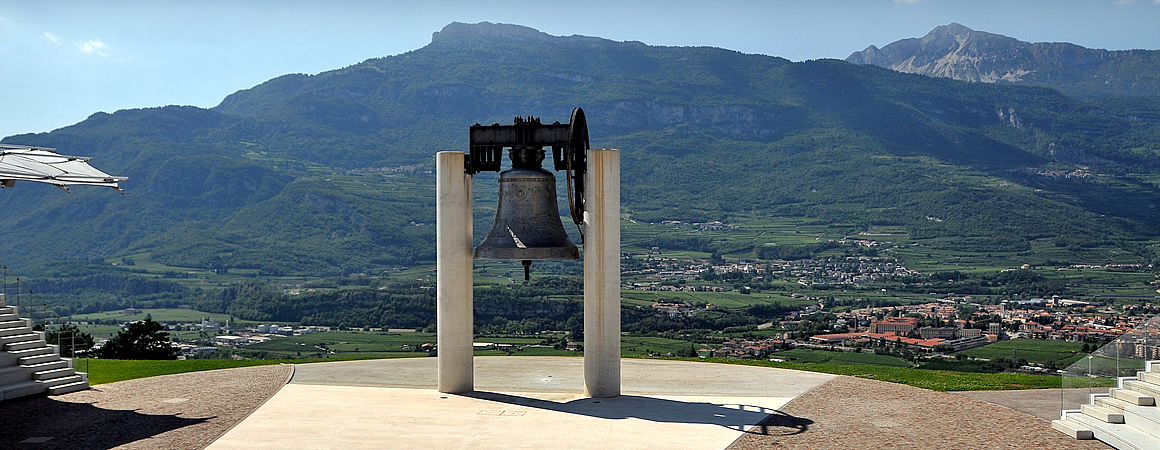At eight in the evening on 3 November 1965, the Bell arrived at the railway station, where a huge crowd had been waiting for hours. It then travelled the length of Corso Rosmini, surrounded and accompanied by the city authorities and an extraordinary crowd, estimated at 15,000 people, finally arriving in the same square which had previously received it twice, fresh from its casting.
Here it was placed between four great bonfires, near the statue of Don Rossaro, and the solemn welcome ceremony was held. This was the third time in the space of fifty years that the Bell stopped in Piazza Rosmini to receive the tribute of the crowds of people who had come to see it, regardless of the changing times and political climate. Indeed, on this occasion the officials no longer included representatives of the royal family, or party officials from the regime, but the ministers and mayors of the Republic, members of the new Regency Board, governors of the Italian Lions Club - who had made the new recasting of Maria Dolens possible - and many others. The welcoming address was given by Mayor Benedetti, who expressed the emotions and enthusiasm of the whole city for the long-awaited return of the holy bronze. This was followed by speeches by Father Jori, the principal smelter and the Governor of the Lions Club. The welcoming ceremony concluded with the Inno alla Patria by Riccardo Zandonai, played by the town band, and the anthem of the Bell, sung by three hundred primary school children and conducted, by strange coincidence, by professor Bruno Meneghelli. As a young boy in 1925, Meneghelli had been chosen to greet the Queen Mother on behalf of all the children of the city on the occasion of the baptism of the first Bell, and - uniquely - he found himself face to face with Maria Dolens in an official capacity for the second time in his life. The Bell stayed in Piazza Rosmini all the next day and, despite the rainy weather, thousands of people from Rovereto and nearby towns came to touch it and admire it close up.  It was especially popular with young people - children above all - for whom this was an exceptional occasion which would remain forever impressed in their memories, just as it did for writers who experienced that day and remember it with intense emotion.
It was especially popular with young people - children above all - for whom this was an exceptional occasion which would remain forever impressed in their memories, just as it did for writers who experienced that day and remember it with intense emotion.
At 9 o'clock on the evening of 10 April 1966, which was Easter Sunday, the Bell made its solemn ringing for the first time, in the presence of some 2,000 onlookers. Hearing the sound of Maria Dolens again after 6 years aroused great emotion among those present. Above all, the sound was perfect, as the newspapers later described. This "official" ringing had been preceded a few days beforehand by a trial, carried out by a technical committee, in order to check both the compliance of the work and the Bell's timbre. This was the true occasion when the ringing of Maria Dolens was heard throughout the valley for the very first time. For the official inauguration, 28 May of that year was chosen, to coincide with the fiftieth anniversary of the killing of Damiano Chiesa (17 May 1916), Cesare Battisti and Fabio Filzi (12 July 1916), which occurred during the First World War in the moat of the Buonconsiglio Castle in Trento.
In this way the "Day of Remembrance" was instigated,
which in some ways echoed the traditional events of "the International Glory of the Bell", dedicated to the memory of the victims of all wars. On the open space of Miravalle no fewer than 10,000 former combatants from many nations were assembled; along with more than twenty delegations from foreign embassies accredited by the Quirinale, they participated in the ecumenical ceremony - evangelist, Orthodox Jewish and Catholic - which took place at the foot of the Bell, unbounded by nationality, language, culture, politics or religion. At the first deep, clear stroke of the Bell, unrestrained applause broke out among the attendees. The Italian Government was represented by the Minister of Communications Giovanni Spagnolli and the Under-Secretary for Defence, Senator Natale Santero. The next day, 29 May, the ceremonies continued at the Castel Dante Ossuary, beginning with the blessing of a plaque featuring a silhouette of the Bell in the atrium of the railway station, dedicated to the patriots Filzi and Chiesa, and to the many railway workers killed in war.






